
Scorpions are predatory arachnids of the order Scorpiones. They have eight legs, and are easily recognized by a pair of grasping pincers and a narrow, segmented tail, often carried in a characteristic forward curve over the back and always ending with a stinger. The evolutionary history of scorpions goes back 435 million years. They mainly live in deserts but have adapted to a wide range of environmental conditions, and can be found on all continents except Antarctica. There are over 2,500 described species, with 22 extant (living) families recognized to date. Their taxonomy is being revised to account for 21st-century genomic studies.
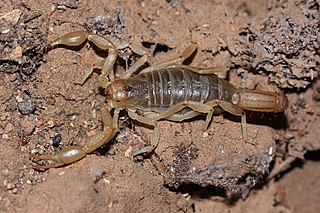
Paravaejovis spinigerus, commonly known as the stripe-tailed scorpion or devil scorpion, is a species of scorpion in the family Vaejovidae. It is found in the south-western United States and north-western Mexico.

The Buthidae are the largest family of scorpions, containing about 100 genera and 1339 species as of 2022. A few very large genera are known, but a high number of species-poor or monotypic ones also exist. New taxa are being described at a rate of several new species per year. They have a [cosmopolitan] distribution throughout tropical and subtropical environments worldwide. Together with four other families, the Buthidae make up the superfamily Buthoidea. The family was established by Carl Ludwig Koch in 1837.

Centruroides is a genus of scorpions of the family Buthidae. Several North American species are known by the common vernacular name bark scorpion. Numerous species are extensively found throughout the southern United States, Mexico, Central America, the Antilles and northern South America. Some are known for their interesting patterning or large size ; most if not all fluoresce strongly under ultraviolet illumination, except after moulting. They contain several highly venomous species, and fatalities are known to occur. The venom of the Mexican scorpion Centruroides limpidus limpidus contains the neurotoxins Cll1 and Cll2.

Euscorpius is a genus of scorpions, commonly called small wood-scorpions. It presently contains 65 species and is the type genus of the family Euscorpiidae – long included in the Chactidae – and the subfamily Euscorpiinae.
The taxonomy of scorpions deals with the classification of this predatory arthropod into 13 extant families and about 1,400 described species and subspecies. In addition, 111 described taxa of extinct scorpions are known.
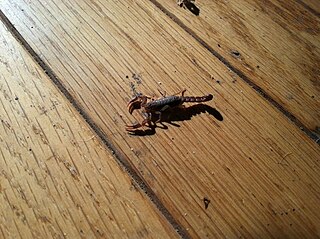
Vaejovis is a genus of scorpions.

The Chactidae are a family of scorpions established by Reginald Innes Pocock in 1893. They make up the superfamily Chactoidea.

The Euscorpiidae are a family of scorpions.

Diplocentridae is a family of scorpions. The roughly 120 species are mostly native to the New World, except for genus Nebo, which is distributed in the Middle East.
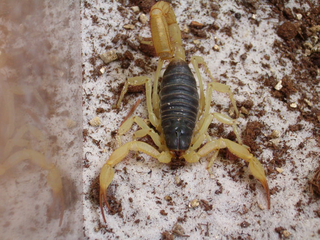
Hadrurus is a genus of scorpions which belongs to the family Caraboctonidae. They are found in sandy deserts and other xeric habitats in northwestern Mexico and in southwest United States. They are among the largest of all scorpion genera, only surpassed by Hadogenes, Pandinus, Heterometrus and Hoffmannihadrurus.
Smeringurus is a small genus of scorpions native to Mexico and the southwestern United States within the family Vaejovidae. It is closely related to the genus Paruroctonus, of which it was formerly considered a subgenus.

Paruroctonus is a genus of scorpions in the family Vaejovidae. There are about 10 described species in Paruroctonus.
Kovarikia, is a genus of scorpion belonging to the family Scorpionidae. All described species are restricted to humid rocky microhabitats of southern California. Three species identified.

Vaejovis carolinianus, the Southern Unstriped Scorpion, also known as the Southern Devil Scorpion, is a species of scorpion in the family Vaejovidae.
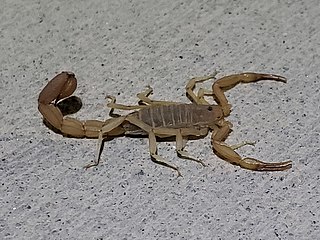
Paravaejovis is a genus of scorpions in the family Vaejovidae. There are about 11 described species in the genus Paravaejovis.

Uroctonus is a genus of forest scorpions in the family Vaejovidae. There are at least four described species in Uroctonus.

Maaykuyak is a genus of scorpions in the family Vaejovidae, found in Mexico and the United States (Texas).
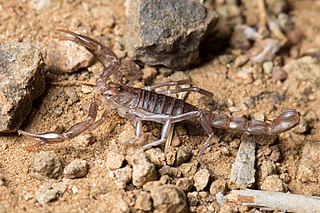
Serradigitus is a genus of sawfinger scorpions in the family Vaejovidae. There are more than 20 described species in Serradigitus.

Diplocentrus is a genus of toothed scorpions in the family Diplocentridae. There are more than 60 described species in Diplocentrus, found mainly in Central America, Mexico, and the southwest United States.
















